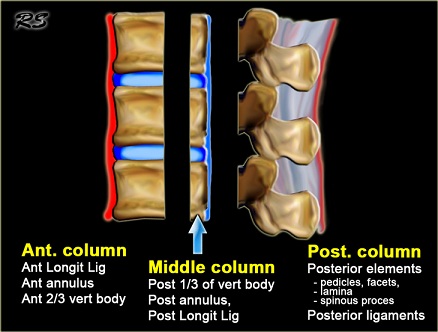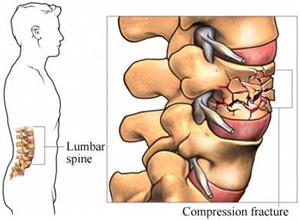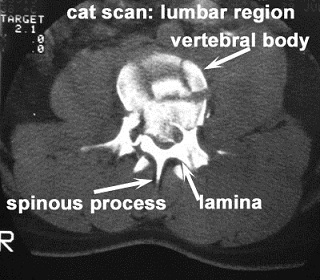Template:TXSTEBP: Difference between revisions
No edit summary |
No edit summary |
||
| Line 98: | Line 98: | ||
== References == | == References == | ||
<br> | |||
<references /> | <references /> | ||
[[Category:Texas_State_University_EBP_Project|Template:TXSTEBP]] | [[Category:Texas_State_University_EBP_Project|Template:TXSTEBP]] | ||
Revision as of 07:18, 2 May 2011
Lead Editors - Thomas Albaugh, Elizabeth Record, Misty Hillin, Patrick Bales
Search Strategy[edit source]
Database Search: CINHAL, Cochrane Library, JOSPT, PEDro, PubMed
Keywords: lumbar, spine, fracture, management, therapy, burst, osteoporosis, nonoperative, treatment, thoracolumbar
Search Timeline: April 13, 2011 - May 1, 2011
Definition/Description[edit source]
The complex shape of the vertebra, along with the interaction of central nervous system, the relatively specialized structures of the intervertebral disks and the associated vertebral ligaments has made the description and classification of spinal fractures an ongoing pursuit for the medical community. The current system had its roots in 1963 after Holdsworth proposed classifying spinal fractures by the MOI of compression, flexion, extension, and flexion-rotation. He divided the injuries involvement of the anterior weight bearing column and the posterior “tension bearing” column of facet joints and ligament complex[1].
The 1983 Denis system revision led to a center column comprised of the posterior vertebral body, posterior vertebral disk and Posterior Longitudinal ligament[2].
In the Denis system it was believed that trauma focused into the middle column was sufficient to cause instability in the spine. The instability was further categorized into three types:
- First degree: considered mechanical
- Second degree: neurological
- Third degree: combined mechanical/neurological
This system is still currently the favored method. The main frustration from the Denis method is that the inclusion of the middle column introduced a “virtual landmark” that isn’t really suitable for determining an injury type. A recently developed system by Aebi incorporates the two column method, combined with the method of injury, and the instability which may result in neurological compromise. This method can result in 27 subgroups of spinal fractures[3]. Obviously the classification of fractures is complicated and ongoing.
The American Academy of Orthopedic Surgeons website[4] lists fractures based on the pattern of injury and in a simpler format:
The flexion pattern contains compression fractures, and axial burst fractures[4].
The extension pattern, which contains an extension/distraction (often called a chance fracture).
The rotation pattern contains transverse process and fracture-dislocation[4].
While the listed examples above all imply trauma for a spinal fracture, osteoporosis and conditions such as osteogenesis imperfect are commonly implicated in vertebral fractures as well.
Epidemiology /Etiology[edit source]
The extension pattern of lumbar fractures:
•A chance fracture results from a distraction accident such as stopping quickly and the force from a seatbelt pulling your vertebrae apart.
The flexion pattern of lumbar fractures:
•Compression fractures are usually caused by an axial load that causes the anterior vertebrae to lose height[4]. Axial Burst fractures are caused by an axial load of a sudden acceleration or deceleration transmitted thru the spine that causes the vertebrae to lose height on all sides.
•Burst fractures may result in some retropulsion of the vertebra into the vertebral canal[5]. Compression and burst fractures are most commonly seen in falls and traffic accidents[5].
The rotation pattern of lumbar fractures:
•Transverse Process (TP) fractures are uncommon and result from extreme sideways bending. These do not usually affect stability.
•The fracture-dislocation is a fracture in which bone and its accompanying soft tissue will move off an adjacent vertebra. This type is an unstable fracture and may cause severe Spinal cord compression.
Characteristics/Clinical Presentation[edit source]
add text here
Differential Diagnosis[edit source]
add text here
Examination[edit source]
add text here
Medical Management (current best evidence)[edit source]
add text here
Physical Therapy Management (current best evidence)[edit source]
Key Research[edit source]
add links and reviews of high quality evidence here (case studies should be added on new pages using the case study template)
Resources
[edit source]
add appropriate resources here
Clinical Bottom Line[edit source]
Lumbar spine fractures, whether from an acute injury or progressive in nature like osteoporosis, occur often enough to merit adequate research with regard to healing procedures. A great deal of inquiry has gone into spinal surgery options, while very little appears to exist for specific physical therapy management. Most of the present information acknowledges that physical therapy, especially that of therapy and bracing can just as effectively manage lumbar fracture pain (without neurological involvement) as that of surgery. However, no current research exists that effectively compares the most effective therapy. Current recommendations revolve around basic core and lumbar spine strengthening as with most lumbar spine insults. It is our recommendation that more research be done in this area that focuses specifically on lumbar spine fractures and the most effective therapy treatments for these injuries.
Recent Related Research (from Pubmed)[edit source]
see tutorial on Adding PubMed Feed
Extension:RSS -- Error: Not a valid URL: Feed goes here!!|charset=UTF-8|short|max=10
References[edit source]
- ↑ Holdsworth FW. Fractures, dislocations and fracture/dislocation of the spine. J Bone Joint Surg Br 1963;45:6-20.
- ↑ Denis F. The three column spine and its significance in the classification of acute thoracolumbar spinal injuries. Spine 1983;8:817-31.
- ↑ Aebi M. Classification of thoracolumbar fractures and dislocations. European Spine Journal. October 2009;19: (suppl I):S2-S7. Accessed April 25, 2011.
- ↑ 4.0 4.1 4.2 4.3 American Academy of Orthopedic Surgeons web site. Available at: http://orthoinfo.aaos.org/topic.cfm?topic=a00368
- ↑ 5.0 5.1 Heary R, Kumar S. Decision-making in burst fractures of the thoracolumbar and lumbar spine. Indian Journal of Orthopaedics [serial online]. October 2007;41(4):268-276. Available from: Academic Search Complete, Ipswich, MA. Accessed April 14, 2011.









